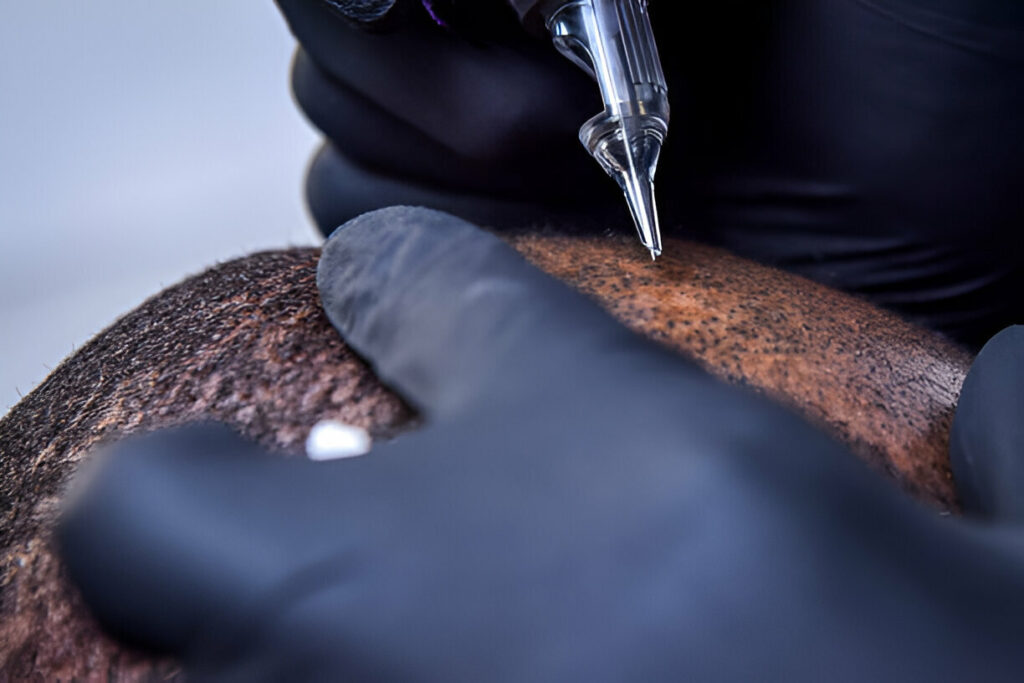More than just a simple skull and bones inking can be achieved with scalp tattoos. When applied as part of the cutting-edge process known as scalp micropigmentation (SMP), a little ink on the scalp can, for many, conceal hair loss.
You’ve undoubtedly heard of standard micropigmentation, which is a tattooing method used to add freckles and give sparse brows fuller arches. That was only the start, though. These days, cosmetic artists print hundreds of tiny dots to resemble hair follicles on the scalp, a practice that has made its way a few centimeters north.
What Is Scalp Micropigmentation?
A tiny needle is used by the provider to apply tiny dots of color to the scalp during scalp micropigmentation. The difference in depth and size of the dots gives the impression of fuller hair. Scars and birthmarks can be covered by scalp micropigmentation, even thinning patches on your scalp. On a bald person, it can also be used to simulate a buzz cut.
What Causes Hair Loss?
A common feature of hair loss is that it usually progresses, getting worse with time. Hair loss-causing conditions affect millions of people and include:
Alopecia areata: Hair loss is a symptom of the autoimmune disease alopecia areata. Immune system disorders cause the body to attack itself. Alopecia areata is a condition in which the body targets hair follicles, leading to erratic hair loss. Some patients have lifelong hair loss, while others see their follicles repair and sprout new hair.
Chemotherapy-related hair loss: Chemotherapy targets the body’s fast proliferating cancer cells. It also targets other kinds of fast proliferating cells, like the roots of your hair. Chemotherapy does not always result in hair loss, and when it does, the effects are typically transient.
Female pattern hair loss: Although over 50% of women also experience hair loss, most people assume that men are the ones who suffer from it. While female pattern hair loss is a prevalent occurrence among women over 40, menopausal women, and women with a family history of the condition, it can affect any woman.
Male pattern hair loss: The most typical cause of hair loss in men is male pattern hair loss. Male pattern hair loss manifests in more than half of white men as baldness, receding hairlines, or thinning hair.
Scars or birthmarks on the scalp: Birthmarks or scars on the scalp may be visible through the hair. These marks can be covered by scalp micropigmentation.
How Does Scalp Micropigmentation Address Hair Loss?
Scalp micropigmentation is a permanent way to hide bald areas and losing hair. Since the procedure doesn’t require anesthesia or surgery, you can get back to your normal routine right away. Tattooing doesn’t have many side effects, though a minor redness may linger for several hours.
Scalp micropigmentation is less invasive than hair transplant surgery because it doesn’t require any incisions or surgery. In addition, it is less costly, requires no downtime, and produces less discomfort.
What are the benefits of hair tattoos?
Realistic results
Considering that we’re talking about hundreds of microscopic tattoos on the scalp, skilled artists can achieve some very striking outcomes. Improved density and coverage can make hair appear more natural from a distance, and hairline tattooing can bring even the most timid hairlines back to life.
Research have indicated that when a practitioner has a high level of ability, restoring hair loss and hiding scars can greatly satisfy patients..
Fairly low risk
When performed by a professional, scalp micropigmentation is a relatively low-risk semi-invasive procedure. While hygienic methods and equipment should minimize the risk, traditional tattoos raise concerns about things like infections.
The fact that the needle just pierces the epidermis means that the pain is actually more bearable in comparison to a typical tattoo. This expedites the healing process, which typically takes a person one week.
Long-lasting
Hair tattoo inks are an excellent long-term treatment for hair loss since, depending on how your body handles them, they can endure for many years. You can go for several years without needing a touch-up, even if there might be some fading over time.
Is Scalp Micropigmentation Permanent?
Scalp micropigmentation is seen as a permanent solution because the initial treatment must be removed with a laser. This is due to the fact that the process entails the insertion of pigment into the scalp via tattoo needles, producing little dots that resemble hair follicles.
Though any procedure involving a conventional tattoo or scalp tattoo is referred to as “permanent treatment,” the quality of SMP results is not permanent. Although the effects may remain for a long time, touch-up procedures are usually required over time, therefore the phrase “permanent” is relative.
What Can Scalp Micropigmentation Treat?
SMP can treat a variety of conditions, including:
- Male pattern baldness
- Female pattern baldness
- Alopecia
- Thinning hair on the crown and sides of your head
- Scarring
- Hair loss due to aging, genetics, hormones, auto-immune diseases, or medications
Scalp Micropigmentation Pros and Cons
Consider the advantages and disadvantages of scalp micropigmentation before deciding if it’s right for you, just like with any operation. Scalp micropigmentation is not a hair loss remedy. It doesn’t alter your natural hair growth pattern or aid in hair growth. It won’t harm your current hair follicles or result in more hair loss, though.
Selecting a qualified provider is crucial, just like with any operation. Depending on the extent of the area to be treated, a single scalp micropigmentation session may last up to five hours. For best results, you could require two or three sessions.
While scalp micropigmentation offers targeted solutions for achieving thicker, healthier hair, FUE therapy at Root Hair Clinic provides a comprehensive approach to hair restoration, ensuring natural-looking results and a fuller head of hair.
FUE Therapy
Follicular Unit Extraction (FUE) is a technique used for hair transplantation, which involves carefully separating and extracting individual follicles from their attachment to the dermis. To achieve this, small micro punches of 0.6-0.8mm are employed – resulting in minimal scarring that’s virtually undetectable!
The technique of hair extraction is limited by anatomy, as it is not possible to see the bulge from the outside. This can lead to a higher transection rate due to hairs diverging in different directions and slow process time per unit pulled out. However, with practice and experience, surgeons can improve their hand-eye coordination for faster execution while reducing transections at the same time.
Root Hair Clinic is one of the pioneers in FUE hair transplantation, offering this revolutionary technology as a preferred method for extracting and transplanting hair. Our highly experienced team of surgeons has undergone special training to perfect their technique and offer superior results to our patients. With Root Hair Clinic’s expertise, you can rest assured that your treatment will be conducted expertly and with utmost care. Contact Root Hair Clinic Korea today to find out more!
Why Root Hair Clinic

At root hair transplant, we give customized hair transplants to all those who need it. However, Root Hair Transplant is proud to provide quality care and service, making the solution long lasting. Ultimately, what sets Root Hair Clinic apart is the quality of results they consistently achieve. Patients can expect natural-looking, long-lasting hair restoration outcomes that enhance their confidence and quality of life.
FAQs
No. Permanent cosmetics and scalp micropigmentation are optional (optional) operations. Inquire with your provider about the procedure’s cost and the total number of treatments you will require.
Many people are happy with scalp micropigmentation when it is done by a qualified practitioner. Scalp micropigmentation requires little care and lasts for many years due to the long-lasting pigments.
Micropigmentation on the scalp does not cause hair growth or alter normal hair growth. In addition, contrary to what you may have read, it won’t harm your current hair follicles or result in hair loss.
Conclusion
Your confidence doesn’t have to suffer because of hair loss or thinning. There are numerous reasons why people lose their hair, including hormone imbalances, alopecia, and male pattern baldness. Or maybe you wish to hide up a birthmark or scar. Using scalp micropigmentation to make your hair appear thicker is a successful, non-invasive method.

